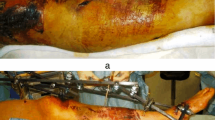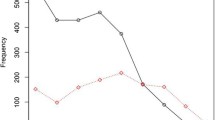Abstract.
During an 18-month period we studied prospectively 63 consecutive patients (42 males, 21 females) with an open fracture of the lower limb. Their mean age was 32 years (range: 4–78 years) and 58 patients with 59 fractures were available until the conclusion of the study. Forty-seven had tibial fractures, 12 had femoral fractures and the majority of the patients were either students or traders. According to Gustilo and Anderson's grading, 21 fractures were of type II and 16 of type IIIA. On arrival all the wounds were irrigated and debrided and the patients also received tetanus prophylaxis and intravenous antibiotics. Of the 47 tibial fractures 39 were managed with an above-knee plaster of Paris cast which was windowed so as to allow wound care. Of the 12 femoral fractures ten were treated with skeletal traction on a Bohler frame. The time taken for soft tissue healing was not significantly different between the tibial and femoral fractures. There were, however, significant differences with respect to (1) the time interval between injury and debridement, (2) the incidence of wound infection, (3) the occurrence of osteomyelitis, (4) fracture union time, and (5) time spent in hospital. The most common complications were wound infections (27 cases) and delayed union (26 cases). The time interval between injury and wound debridement was a major prognostic factor.
Résumé.
Pendant une période de 18 mois nous avons étudié 63 patients (42 hommes, 21 femmes) présentant des fractures ouvertes du membre inferieur. Leur âge moyen était 32 ans (4–78 ans): 5 des patients ont été perdus de vue et 58 patients avec 59 fractures ont été etudiés; 47 patients avaient des fractures du tibia, tandis que 12 avaient des fractures du fémur. Les étudiants et les commerçants représentaient la majorité des cas. En utilisant la classification de Gustilo et Anderson: 21 fractures étaient de types II et 16 de type IIIA. Tous les patients ont reçu une prophylaxie anti-tétanique, des anti-biotiques par voie veineuse et le débridement et l'irrigation des blessures. 39/47 des fractures du tibia ont été immobilisées par un platre cruro-pédieux, fenêtré pour permettre les soins locaux. La traction tibiale sur cadre de Böhler a été utilisé pour 10/12 fractures du fémur. La durée de cicatrisation des parties molles n'était pas différente selon la localisation au tibia ou au fémur. Par contre il y avait des différences significatives en considérant: (1) l'intervalle de temps entre l'accident et le débridement; (2) l'incidence de l'infection des plaies; (3) l'occurrence de l'ostéomyélite; (4) le temps de consolidation des fractures et (5) la durée d'hospitalisation. Les complications communément observée étaient les infections des plaies (27 cas) et le retard de la consolidation (26 cas). Le délai entre le traumatisme et le parage de la plaie était un facteur majeur de pronostique.
Similar content being viewed by others
Author information
Authors and Affiliations
Additional information
Electronic Publication
Rights and permissions
About this article
Cite this article
Ikem, I., Oginni, L. & Bamgboye, E. Open fractures of the lower limb in Nigeria. International Orthopaedics (SICOT) 25, 386–388 (2001). https://doi.org/10.1007/s002640100277
Accepted:
Published:
Issue Date:
DOI: https://doi.org/10.1007/s002640100277




